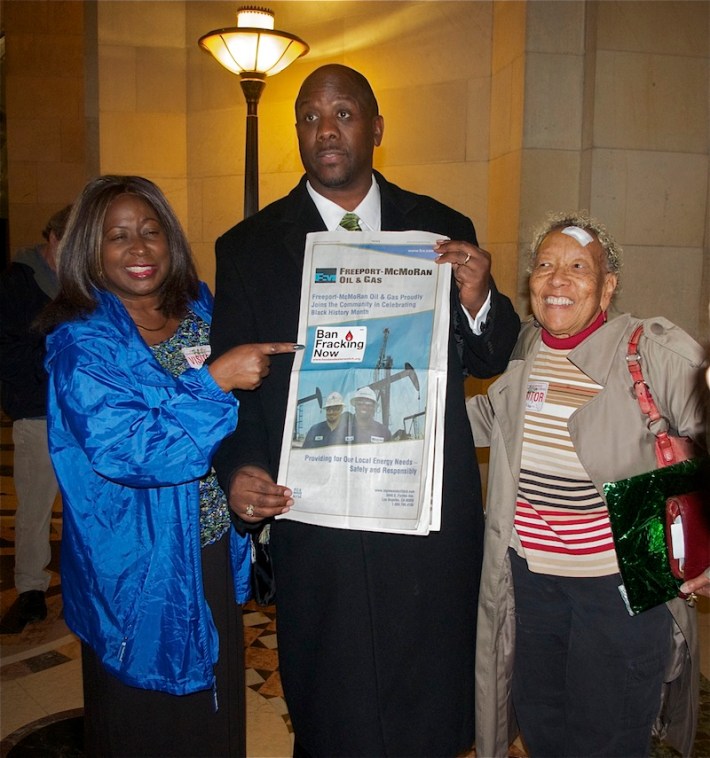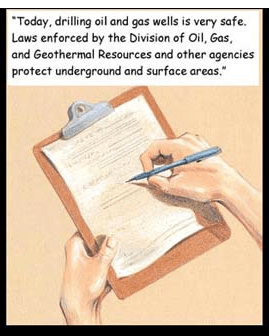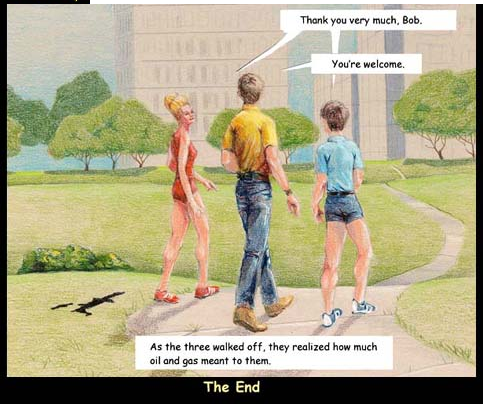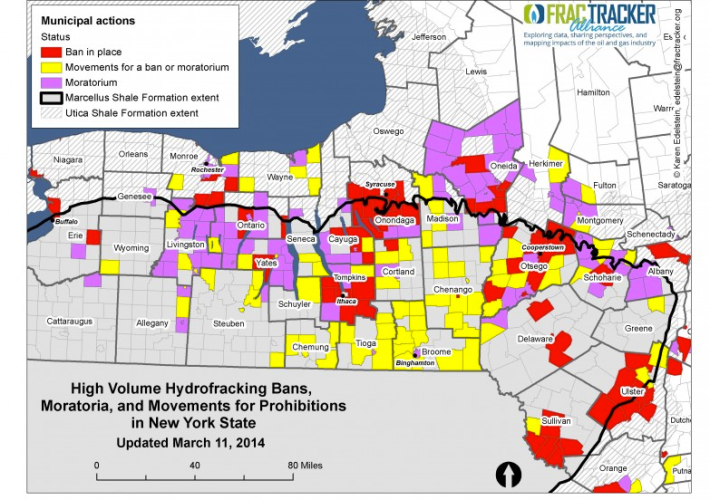“Our Fears Have Not Been Allayed”: The Limits of Regulatory Powers Over Unconventional Oil and Gas Extraction Techniques
5:02 PM PDT on March 14, 2014

"Qué significa 'fracking' en español?" the woman wearing a "People Not Pozos" shirt and a "Ban Fracking Now" sticker asked me.
I scratched my head.
Shouldn't she know? I wondered.
And, how exactly does one say, "Fracking is a 'well stimulation treatment that...includes the pressurized injection of hydraulic fracturing fluid or fluids into an underground geologic formation in order to fracture or with the intent to fracture the formation, thereby causing or enhancing...the production of oil or gas from a well'" in Spanish, anyways? It’s not like it rolls off the tongue all that easily in English.
The broad definition I stumbled my way through apparently satisfied her because she smiled, nodded, and turned her attention back to an oddly clad gadfly making his way to the center podium in order to address the members of the City Council.
"I love prostitution!" he proclaimed.
Earlier, he had waved a bag of lollipops in the air and announced to the councilmembers that he had brought one for each of them because they knew how to suck.
Clearly, I do not hang out here often enough, I thought.
Finally, it was time for Council President Herb Wesson to turn his attention to the motion much of the packed-to-the-gills house was waiting for. Put forward by Councilmembers Paul Koretz and Mike Bonin, it would take the first step toward limiting unconventional oil well stimulation practices within Los Angeles until they could be proven safe.
“Mr. Koretz, treasure that ovation,” winked Wesson, as the crowd stood to enthusiastically applaud what they felt to be the courageous efforts of the councilmembers to wrest back some control over community health from the oil corporations.
Among those present February 28th to witness the unanimous vote were representatives of several environmental organizations and community groups that have dedicated much time and energy to lobbying against harmful drilling practices and educating the public about them.
Many were also just regular people, like the woman who had asked me to translate "fracking" into Spanish for her, or another young community organizer who said he had gotten involved in the fight because of fears that oil companies were "destroy[ing] our health." For them, the fight was clearly personal. But, when pressed for details, some of them struggled to articulate exactly what it was they thought the oil companies were doing in their communities or how those practices were affecting them.
There are reasons for that.
Part of it has to do with the general lack of transparency that has surrounded oil and gas extraction for years.
Until this year, corporations had never been required to notify regulatory agencies when and where they would be using fracking or other unconventional drilling techniques. This was due, in large part to the singular reluctance of the Department of Conservation’s Division of Oil, Gas, and Geothermal Resources (DOGGR) – the very agency tasked with regulation and oversight of the drilling, operation, maintenance, and abandonment of oil and gas wells – to require reporting.
And, any data that was reported seemed to conveniently fall into a bureaucratic black hole.
In a written response to legislators’ request for specifics regarding well stimulation activities in California just last July, for example, the Director of the Department of Conservation acknowledged that they did “not have specific information on well stimulation operations in a searchable database, nor [did they] have the resources to dedicate to review thousands of scanned documents.” He goes on to reiterate that, because DOGGR’s chief concern is well integrity, they focus on well construction rather than the actual activities the wells are subjected to.
Thanks to the highly flawed, but significant, step forward made with Senate Bill 4 (SB-4), that is slowly beginning to change.
While the bill may not stop – or even slow down – fracking, as of January 2014, corporations are required to inform DOGGR of the techniques and chemicals used in their extraction operations within 60 days of the completion of the work. Watered-down versions of the information will be made available to the public (so as to protect trade secrets) and a study will be conducted to evaluate the risks of fracking so that further appropriate regulation may be crafted next year.
Also helpful has been the Air Quality Management District’s (AQMD) Rule 1148.2 (adopted last year) which requires that corporations notify the AQMD between 10 days and 24 hours before drilling, reworking, or completion of wells using gravel-packing, fracking, or acidizing techniques. The objective is to be able to notify the public (you can search their new, yet oddly antiquated, public database here, just be sure to have Internet Explorer and use exact search terms, or you will come up empty-handed) of operations in their communities and to ensure that the appropriate air quality monitoring can take place. While air monitoring itself can be fraught with problems around sites like the Inglewood Oil Field in Baldwin Hills, where the placement and type of monitor can impact what is detected, the notice at least ensures that someone knows when and where drilling will be happening.
Self-reporting has its drawbacks, of course.
A recent dispute between West Adams neighbors and the oil and gas behemoth Freeport-McMoRan (FM O&G) – which operates several wells in the neighborhood as well as the Inglewood Oil Field – appeared to hinge on whether FM O&G had properly documented the number of wells drilled and methods used at the Murphy site in their report to the AQMD.
And, in the last few days, neighbors have again been alarmed by what appear to be the presence of drilling rigs and activity at the Murphy site in violation of the temporary stay placed on drilling there in January. They are trying to square what they are seeing, what they are being told by FM O&G with regard to the operations having to do with run-of-the-mill extraction work, and the knowledge they’ve scrambled to piece together about complex and “unconventional” drilling processes.
Regardless of what might or might not be happening at the site, the lack of transparency and resulting distrust of a corporation dubbed by some as the “worst corporation on Earth” has left the community feeling that their hyper-vigilance is the only answer.
Which brings me to the other key reason that people are unsure of what activities are occurring in their communities: the question of what constitutes “fracking.”
The term has come to serve as a nebulous catch-all for a variety of extraction methods.
It's easier to engage and organize people around "fracking" than a complicated list of practices, acknowledged Brenna Norton of Food & Water Watch (FWW), one of the organizations present at City Hall for the vote.
And, true as that may be, the consolidation of concerns into one umbrella term oversimplifies the problem and makes it easier for its proponents to both pooh-pooh concerns about the practices and divert attention from other, potentially more harmful, unconventional drilling methods.
“Stopping fracking is the latest cause of the silly people,” wrote Fox News’ John Stossel last year.

Conceding that, “Yes, cracking rocks does cause vibrations,” in response to concerns about earthquakes, he suggested, “But then, so does construction with dynamite or jackhammers -- not to mention trucks on the highway.”
In response to the recent L.A. City Council vote, Hance V. Myers III (Vice President - Corporate Information Director of FM O&G) argued fears of fracking had a more sinister effect. The moratorium's "generic scope," he claimed, could halt "even routine well maintenance activities needed to ensure the mechanical integrity of wells and maintain conventional oil production.”
Rock Zierman, CEO of the California Independent Petroleum Association (CIPA), concurred, writing that, “It appears that environmental groups are using fracking as a boogeyman to achieve their real goal…banning all domestic oil and gas production.”
CIPA has argued in the past that excessive regulation or disclosure of trade secrets are unnecessary, as the majority of fracking occurs in rural areas where there is no potable water, no surrounding population, and no other significant business interests to worry about. They even went so far as to "announce the national launch" of and host screenings for one of the greatest pieces of corporate propaganda to cross my desk in a very long time. Entitled “Truthland,” it is presented as a “factual alternative” to the documentary “Gasland,” and is narrated by a folksy Pennsylvania farmer named Shelly Depue (who apparently was unaware at the time that the wells on her own property had racked up several violations for faulty well casings and other issues).
At the PLUM committee hearing a few days prior to the City Council vote, Nick Ortiz of the Western States Petroleum Association reiterated the position of many within the industry that hydraulic fracturing was a “safe and proven” technology that has been "in use for over 60 years and has never been associated with any confirmed case of groundwater contamination or any other environmental harm."
It’s a claim Norton has no patience for.
"It's not your grandmother's 'fracking,'" she said, citing the increased pressure during drilling, excessive water use, horizontal drilling, and the incorporation of hazardous chemicals into contemporary practices that have allowed corporations to re-work wells that became too costly to keep open using more traditional fracking and extraction methods.
Others, like Paul Ferrazzi, Executive Director of Concerned Coalition of Citizens for a Safe Community, fear things like methane migration – responsible for the contamination of wells in Pennsylvania and possibly also for the explosion that rocked a Ross Store back in 1985 – through an already porous and fault-ridden landscape.
The “cracking of rocks,” in other words, is the least of their worries.
In fact, when residents lodged more than 250 complaints with the South Coast Air Quality Management District (SCAQMD) regarding the poor practices of AllenCo at a site next to Mount St. Mary’s College on 23rd St., for example, they weren't complaining about fracking at all. Instead, it was likely the acids AllenCo used to unplug and/or stimulate older wells that had triggered the nausea, dizziness, headaches, nosebleeds, and respiratory ailments that residents -- and even EPA officials conducting an on-site visit -- experienced.
Similarly, residents living near the Murphy (2126 W. Adams) and Budlong (at Jefferson, near USC) drill sites have been repeatedly told by representatives of operator FM O&G that they have nothing to fear, as FM O&G is not fracking there.
And, while it may be true that wells are not being fracked there, for neighbors worried by loud noises, acrid smells, and trucks lumbering through the neighborhood with thousands of pounds of acids in tow, FM O&G's reassurances regarding fracking have brought little comfort. They are concerned that, like AllenCo, FM O&G is employing some form of acid stimulation – a newer technique that involves pumping thousands of gallons of acids into wells to "melt" or “dissolve” any residual limestone, dolomite, or calcite cement impeding the flow of oil through sediment grains of reservoir rocks -- to get at previously-out-of-reach oil deposits.
If there was nothing to fear, they wondered, then why was FM O&G so adamant that public hearings be waived in their application for permits to drill and re-drill several wells at their Budlong site last year?

Most frustratingly for residents, it seems, was the question of why the burden of oversight of drilling operations and the use of dangerous chemicals appeared to have fallen to them.
“Acidation [sic] was never in my vocabulary. It entered my vocabulary about six months ago," said Pastor Kelvin Sauls of the Holman United Methodist Church of the challenge of educating himself and his parishioners about drilling practices.
In his hands, he held a copy of the L.A. Sentinel that had been opened to the full-page ad that FM O&G had taken out in anticipation of the City Council vote.
He and other community members had rolled their eyes over the claim that FM O&G was "Providing for our Local Energy Needs -- Safely and Responsibly" and slapped a "Ban Fracking Now" sticker on it.
Looking at the ad and the proud oil workers it purported to showcase, I had to wonder what good would actually come of the City Council vote.
The bulk of FM O&G’s (and other corporations’) drilling goes on outside the city limits. The Inglewood Oil Field and its thousand-plus wells? They are in unincorporated L.A. County and thus unaffected by the ruling, despite the fact that it is city residents in Baldwin Hills who are impacted by the operations there.
Several of the organizers I spoke with after the vote acknowledged the challenges that lay ahead.
“Fracking is not our problem,” said Pastor Sauls, referring to the activities at the Murphy and Budlong sites.
So, he was determined to continue working with the city attorney’s office to ensure that their specific concerns were not left out of any regulation.
“Fracking, acidation [sic], gravel packing… [The oil corporations] continue to research new methods. So, we will keep up with them.”
Others were concerned about whether the ban on unconventional practices would hinge on whether (and how) harms to health or water could be proven in a study.
By what metrics would the City Council feel “assured of the long-term safety, security, and reliability of current and future Los Angeles water supplies, the overall health and safety of the people of Los Angeles and the safety of their property from seismic or subsidence concerns related to the exploration and production of oil, natural gas, or other hydrocarbons, and the maintenance of environmental quality”? And, do they really have the authority to require that the “companies conducting fracking...or in areas providing drinking water to the City, can mitigate the effect on climate change, protect environmental quality and natural resources, promote community awareness, allow government access to and testing of chemicals used, anticipate and include related older and emerging technologies such as hydraulic fracturing, acidizing, gravel packing, and all wastewater disposal, and require full disclosure and testing of sites, with adequate time for public input” as the motion reads?
As Pastor Sauls noted, “the devil is in the details” and the language of follow-on legislation and regulation will matter a great deal.
FWW’s Norton agreed that the city taking on such a big issue is not a perfect solution, but, “If Governor Brown is going to fail to protect cities, the cities have a right to lead.”
And, it could be effective, she said, ticking off a long list of other communities whose residents, apparently frustrated at the slow pace of regulation and the interference of powerful oil lobbies, have moved to use the powers at their disposal to limit drilling in urban areas.
Utilizing zoning ordinances and other creative maneuverings, over 100 communities in New York have put bans in place or are in the process of doing so. Just last December, Dallas "adopted one of the nation’s most restrictive ordinances on natural gas drilling" by ruling that gas drilling cannot occur within 1500 ft. of a residence or other protected entities. It effectively pushes drillers, who had previously been able to set up shop as close as 300 ft. from homes, right out of the city.

In Colorado, Fort Collins approved a five-year moratorium on fracking within the city limits, while Lafayette amended its city charter to make the practice illegal. Both were promptly sued by oil corporations who argued the legislation was pre-empted by state laws regulating oil and gas extraction. That move was promptly countered by a group that proposed a constitutional amendment that would allow municipalities to ban fracking and any other hazardous industrial practices that fell within their jurisdictions.
Creative zoning may even be useful in West Adams, suggested DonnaAnn Ward, an active voice with CoWatching Oil L.A. in pushing back against FM O&G in South L.A. The Murphy site falls within the Historic Preservation Overlay Zone, meaning that the sound barrier FM O&G erected and other structural changes they’ve made to facilitate extraction may be violations of the ordinance. Being forced to remove or alter them, she felt, could hamper their ability to drill.
As of this writing, activists from the West Adams area are gearing up to head north to join in the Don't Frack California! rally and march that will be held in Sacramento tomorrow, March 15. They are going to show their support for SB 1132, introduced by Senators Holly Mitchell and Mark Leno, which would place a moratorium on fracking and well stimulation, including acidization, onshore and offshore, until a study of the impacts of unconventional drilling practices on public health and the environment could be completed and the practices certified as safe.
This bill, as you might guess, is also not perfect.
Although it would require that, “All well stimulation treatments shall be prohibited until the scientific study… is completed and all of the requirements…are met,” it also appears to make an allowance for “vested interests” who can appeal to the division to allow them to keep drilling under the moratorium, provided they can prove their interests are indeed “vested.” (see Section 3161 of SB 1132)
In other words, depending on what “vested interests” are interpreted to mean, well stimulation may very well continue apace, even as a study about its impact is underway.
And, it isn’t clear that either the L.A. city ban or SB 1132 will do much at the moment to curb drilling activity in South L.A.
Freeport McMoRan is looking to begin drilling three new wells at the Budlong site in April.
“Our fears,” concluded Ward, “have not been allayed.”
Information about the rally and transportation leaving tomorrow morning from West Adams can be found here.
Sahra is Communities Editor for Streetsblog L.A., covering the intersection of mobility with race, class, history, representation, policing, housing, health, culture, community, and access to the public space in Boyle Heights and South Central Los Angeles.
Stay in touch
Sign up for our free newsletter
More from Streetsblog Los Angeles
Automated Enforcement Coming Soon to a Bus Lane Near You
Metro is already installing on-bus cameras. Soon comes testing, outreach, then warning tickets. Wilshire/5th/6th and La Brea will be the first bus routes in the bus lane enforcement program.
Metro Looks to Approve Torrance C Line Extension Alignment
Selecting the relatively low-cost hybrid alternative should help the oft-delayed South Bay C Line extension move a step closer to reality




